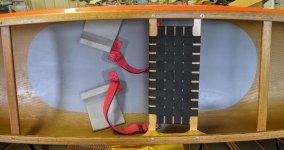I'm not clear on what you think is "wrong", ironandwood. No matter what seat you sit in, moving some gear in a lightly laden boat can change the trim. The idea is to place the gear so the trim feels efficient.
In my opinion (but not everyone's), it's even more important when soloing to place your body in a position to maximize efficient trim in an empty canoe.
A 16' Penobscot is not so wide that it can't be paddled effectively from a centralized seat. But, as Yellowcanoe has pointed out, for "central seated paddling" the front edge of that seat should be 5'-10" aft of the geometric center of the canoe, depending on the height, arm reach and weight of the paddler. Measure it. If the front edge of the seat is too far forward, you will have to move it somewhat aft to get proper empty boat trim for you as paddler.
But, as I said, even when you have properly trimmed a centralized seat for your body in an empty canoe, sliding gear back and forth will affect that trim somewhat. In addition, if these normal and slight changes in trim are affecting your ability to control the canoe solo, it may just be a matter of getting more experience, practice and training in solo canoe technique.

